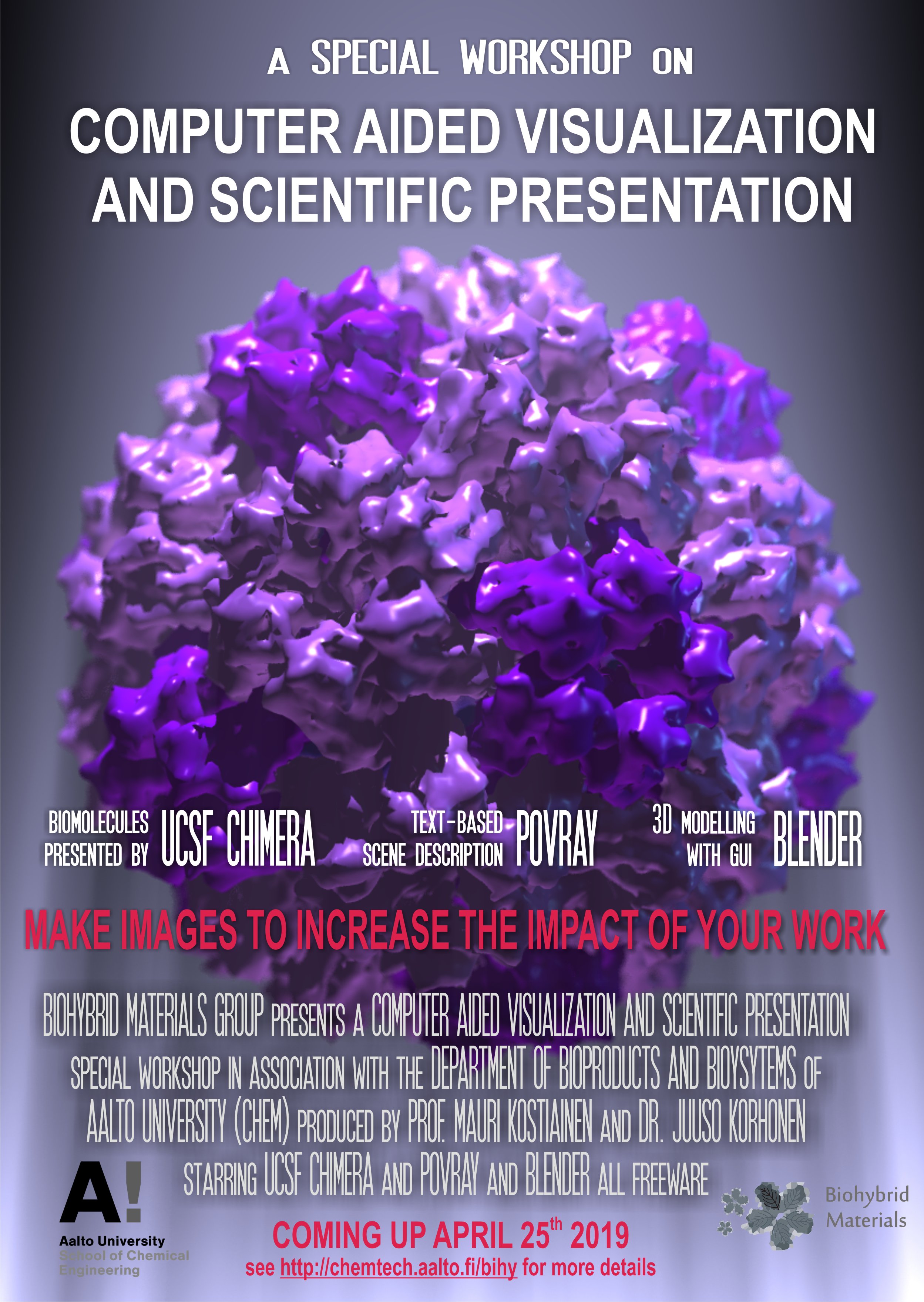CHEM-E2165 - Computer Aided Visualization and Scientific Presentation, 25.04.2019-16.05.2019
This course space end date is set to 16.05.2019 Search Courses: CHEM-E2165
Topic outline
-
Welcome to the course!
Would you like to learn how to create striking 3D images to visualize your science projects, design journal/thesis cover pictures or eye-popping posters? Come and join our new workshop on computer aided visualization!
This course/workshop teaches how to make 3D rendered images of different science related topics. The course provides basic software tools for visualization, 3D modelling and rendering. The aim is to promote creativeness and artistic way of presenting science. Special focus is placed on the visualization of organic compounds, biomolecules and their animations. The course uses three open-source software products: UCSF Chimera (protein and volume structures), PovRay (text-based scene description) and Blender (3D modelling with GUI).Course Teachers:
Prof. Mauri Kostiainen Course teacher (D404, mauri.Kostiainen@aalto.fi)
Dr. Juuso Korhonen Teacher for Blender (juuso.korhonen@aalto.fi)
Antti Korpi Course assistant (D406, antti.korpi@aalto.fi)Learning outcomes:
1) knows the basic functions of the given softwares
2) can identify creative and artistic ways of presenting science
3) is able to produce 3D rendered images
4) can produce simple animations
5) can start working on a visualization topic from own study / research field
6) is able to present scientific topics in visually appealing manner
The course is open and free of charge for everyone, however the maximum number of participants is limited to 15 due to the size of the computer class. Students are eligible to three credit points (includes a project work). This is an introductory level course and no prior experience with these software is needed. The course consists of three contact days:
Day 1 (25.4. 10:15-16:00): UCSF Chimera
Day 2 (2.5. 10:15-16:00): PovRay + Software integration: from Chimera to PovRay + Animations
Day 3 (8.5. 10:15-16:00): BlenderDay 4 (16.5. 10:15-16:00): Independent working. The computer class has been reserved for you if you need to use softwares that are not freeware. I will also be there (12:15 onwards) to answers questions or help with the project planning etc.
Day 5 (11.6. 10:15-14:00): Project presentations. Please note that the location for day 5 is KE5 (D311, Kemistintie 1).
Location: CHEM building, computer class 2 (Kemistintie 1, 02150 Espoo).
If the course becomes overbooked it is still possible to join if you can bring your own laptop, install the softwares (MS Office, ChemOffice, UCSF Chimera, PovRay, Blender) and find a free table corner in the class.
To get credits (3 cr):
1) Attend all lectures. (24 h)
2) Project work producing an image, video etc. (any scientific topic, must use at least two programs from Chimera/PovRay/Blender) individually or in small groups. (41 h)
3) Learning diary, min 2000 words and four figures (Describe and reflect what you have done. Focus on your project, but you may include also the lectures. One diary for the entire course). Written individually even if project work is done in a group. (8 h)
4) Presentation of the work (normal presentation during the presentation day or blog, Youtube video, website, journal/thesis cover etc.). (8 h)To get additional credits (2 cr):
Complete exercises 1-3.
Deadline for projects works and exercises is 9.6. Please return your work + report to MyCourses. Submit both the original Blender/PovRay/Chimera files and the final rendered images/videos etc.
Presentations are given on (11.6.) 10:15-14:00 (computer class 2, Kemistintie 1, 02150 Espoo). Max. 15 min. each.

